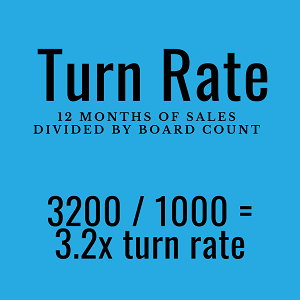“How many frames SHOULD I have in my inventory?” is one of the most common but also most important questions an optical manager should ask and answer. It is a close sister to a more basic question – “How many frames DO we have in our inventory?” If you are one of the many, the busy and the stressed you might struggle to answer.
Inventory is like dollar bills hanging on your frame boards. You bought it and now you own it. The management of this asset is directly related to your bottom line profits, so… what should you do?
Start by gathering the following information
- How many frames did I sell in the last 12 months?
- How many frames did I sell by vendor and brand?
- How many frames did I sell by price point? Create simple groups like under 100, 100-200, 200-300,300-400, Over 400.
- Create a list of all of your brands with their discount percentages and return policies.
- What is my current inventory? Include everything! The frames on your boards, under cabinets and hiding out in back rooms. Detail the number of pieces and the cost.
Calculations are your best friend

Your next step will be to do some calculations. The most critical is TURN RATE. Turn rate is a ratio and is defined as the number of frames you sold in a 12 month period divided by the number of frames you stock in your inventory. For example, if you have 1000 frames on your frame boards and you sold 3200 frames last year then your turn rate is 3.2. Any number over 3 is a good number. A turn ratio of 4 is a great number.
Knowing your global turn rate number is critical but you also want to do these same calculations by brand. Let’s say for example you have 50 frame board spaces for Coach but only sell 100 Coach frames per year. That means your turn rate for Coach is 2. Maybe you have 50 pieces of L.A. Eyeworks but you sell 250 pieces of L.A. Eyeworks each year. That would be a turn rate of 5. It might be a good idea to drop the number of Coach frames and increase the L.A. Eyeworks frames.
You can apply this same thought process to your price points. Look at what your staff sells in relation to what is on your boards. You may LOVE high end frames and so you have filled 50% of your spaces with frames that retail for more than $400. Looking at these numbers you may find that only 10% of what you sell is over $400. This is a common and costly mistake. In our scenario above of 1000 frames, that means 500 frames cost approximately $200 or greater. That portion of your inventory now is representative of $100,000 of your resources. Dropping that price point to a number closer to actual sales (let’s say 20%, instead of 50%) and moving 30% of the inventory to a lower cost point ($100) will drop your inventory by $30,000.
Make adjustments and evaluate regularly
Once you have the information you can make changes. Your efforts may produce the following new targets and recommendations.
- Drop inventory count from 1500 frames to 1200 frames
- Reduce inventory average cost from $100 to $80
- Discontinue brands that aren’t selling or whose return policies are leaving you with stale stock
- Set target counts for brand by price point and gender groups (mens, womens, unisex, kids)
What I see and what happens too often is that changes are decided, they are published and discussed. A month later they are forgotten and the physical inventory is back at 1500. The key is to hold everyone involved in inventory purchasing and management accountable. Make sure you are reviewing the numbers monthly (weekly is even better) and are making improvement decisions based on new information quarterly. Inventory management is an art and it is never finished.
